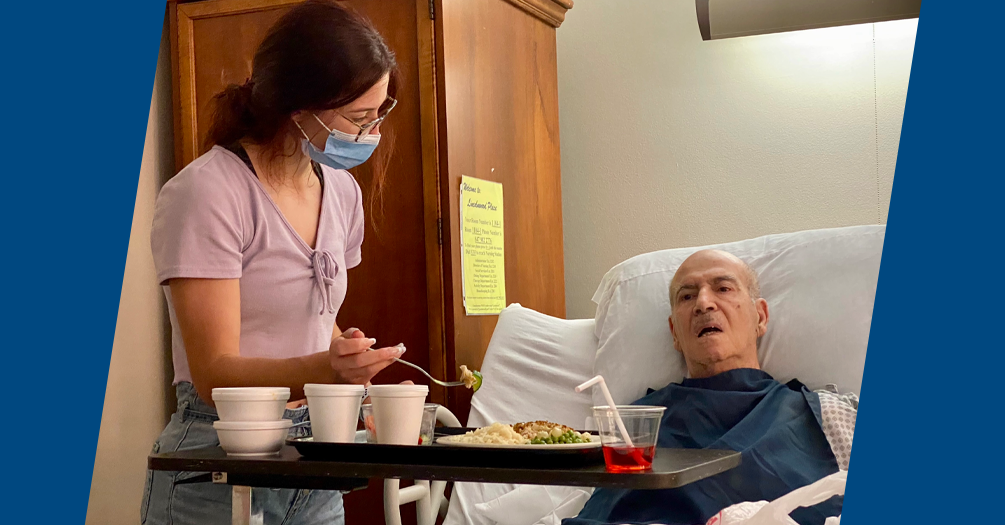The reality of COVID-19 in assisted living facilities

Morgan Jones
Master’s student in Nutritional Sciences
Image description: Maeve Jones, my sister, feeding my Grandpa. He suffered a stroke in September of 2019 and was in a skilled nursing facility from then until he passed in December of 2021. He declined more rapidly during COVID, and this picture was taken 6 months before his passing. Photo courtesy of Melissa Jones.
When the COVID-19 pandemic was just beginning, everyone in my college house immediately packed up their things and fled the scene. My home, over a thousand miles away in Texas, was not as accessible compared to those whose homes were close to our college campus in Ann Arbor, Michigan. Feelings of uncertainty remained as my roommates disappeared, leaving me alone with my thoughts as I waited to be picked up. How much should I pack in my suitcase? When will I be back? Will I be okay?
It took me a few days to get back to my home, and once I was there, I felt immediately suffocated in quarantine. Instead of waking up to the sound of eight roommates getting ready for school in the morning, I was now greeted by uncomfortable silence. My previously eventful college life now started and ended with Zoom, spending every waking moment on the same chair I’ve had since I was 14, working at the same wooden table, and surrounded by the same people. Dad was always in his office, his voice reverberating throughout the house during his daily work calls. Mom seemed to never move from her corner on our old brown couch, her constant presence creating an indent in the fabric as she watched another new Netflix series. My sister, who spent most hours confined in her room, was only occasionally visible when she came downstairs for meals. The monotony quickly grew old, and I began searching for ways to break my mundane routine. Instead of re-reading my biochemistry notes in preparation for my next online exam, I began looking for jobs in the healthcare field.
While work opportunities were lacking due to the pandemic, I heard from a friend that a nursing home back in Ann Arbor was desperate for more aides. I applied and got the job right away, and although I was free from the repetitive and mundane life I left at home, I was instead immersed in an environment full of sadness, grief, and frustration. In my year and a half working there, I bonded with many residents while also watching many of them pass. While the relationships I formed were very personally impactful, I realized that we could be doing more to address the systemic issues affecting both employees and residents in nursing homes.
Essential worker burnout
Employees like me working in entry-level healthcare jobs are overworked, underpaid, and underappreciated. I would work afternoons, starting at 3 p.m. and ending at 11:30 p.m. Many times I was staffed alone, caring for up to 12 residents at a time. The residents completely relied on me for their daily needs, including medication, food, and hygiene.
Other aides were scheduled but wouldn't show up, requiring the staff to quickly adapt and spread our resources thin. My back and joints would ache as I lifted and transferred dozens of residents back and forth for hours in and out of their wheelchairs. I spent much of my time speed-walking from room to room through the eerily silent corridors, the monotonous off-white walls twisting my sense of direction. The lingering smell of cleaning chemicals singed my nose and made me nauseous, even through my suffocating N-95 mask.
As new employees were hired and trained, I witnessed their desire to help others quickly dwindle as the physical and emotional toll of our work environment overcame them. Although they came in excited to interact with the elderly, most quit after only a few short weeks. Like many nursing homes, mine struggled with retaining staff because of the challenging work environment, low-wages, and the crisis around the pandemic. These issues further exposed the shortages in staffing essential workers, and consequently, we weren’t able to provide the highest quality of care that every resident in the facility deserved.
Furthermore, I saw a drastic decrease in the care for the residents in memory care units. I recall entering their rooms and seeing their pants soaked in their own urine because the aide before would not change them into a new set of diapers and pants. It was so disheartening to witness discrepancies of care given to these residents with Alzheimer’s disease or related dementia, and even sadder to realize that these residents did not know they weren’t receiving adequate care.
Passing in threes
My supervisor once said something to me that I still think about today: “We are surrounded by those at the end of their life. I’ve noticed that they pass in threes.”
At first, I thought this to be an exaggeration. There’s no scientific evidence for why the death of one resident would lead to the death of others. However, my extended time working so close to death has opened my eyes to the truth; nursing homes are glorified graveyards.
When a resident enters the facility, they embark on a journey toward death. Many residents arrive at the nursing home spirited and cheerful, but decline rapidly in just a few weeks, passing away only a month after being admitted. The majority of residents arrive alone as their partner often passes before them. This loneliness only furthers their already declining physical and mental health. The ongoing pandemic and limited visitation multiplies feelings of isolation and apprehension toward physical contact with loved ones. Even when residents are cared for, surrounded by their peers, and entertained with “enrichment” activities, the sense of isolation persists. Caretakers are few and far between, and even then, stay at most a few months. Residents are unable to build trust or form a lasting relationship with their caretakers due to poor funding and work conditions that drive essential workers away. In the end, the aura of death consumes these residents, to the point where they themselves lose their taste for life.
Watching this process firsthand opened my eyes to the reality of nursing care units, and at the time I completely agreed with my supervisor’s statement. Nursing homes don’t provide the level of care our elderly need. Residents are admitted with the help of their families, but ultimately die alone. Their bodies are swiftly removed, and their rooms once full of color become devoid of evidence of their existence. That same room is now prepared to house yet another dying resident, and a cycle of death emerges. While my supervisor said this cycle occurs in threes, I’ve come to realize that in reality, this cycle is never-ending.
The pandemic has highlighted the systemic flaws in our end-of-life programs. COVID was not the reason behind the lack of visitation; rather it was an excuse. Even as worries over the pandemic lessened and visitation restrictions were lifted, many residents still died alone. Our society cruelly lacks the motivation to care for our elderly. Healthcare workers try to make a difference each and every day, devoting their lives to helping others, but nursing and hospice care still remain undervalued. In the end, I felt like just another disposable employee, working at another glorified graveyard.
About the author
 Morgan Jones is a first year Nutritional Sciences MPH student at the University of
Michigan. She completed her undergraduate degree from University of Michigan in May
of 2022 with a major in Molecular, Cellular, and Developmental Biology (MCDB) and
a minor in Science, Technology, and Society (STS). She is interested in Maternal and
Child Nutrition and is planning on applying to Physician Assistant schools after completing
her masters.
Morgan Jones is a first year Nutritional Sciences MPH student at the University of
Michigan. She completed her undergraduate degree from University of Michigan in May
of 2022 with a major in Molecular, Cellular, and Developmental Biology (MCDB) and
a minor in Science, Technology, and Society (STS). She is interested in Maternal and
Child Nutrition and is planning on applying to Physician Assistant schools after completing
her masters.
